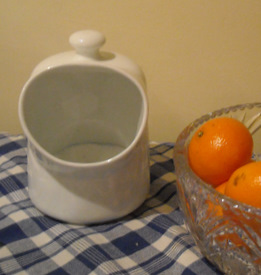Salt Pig
Posted by Fiona Nevile in Kitchen equipment | 24 comments
“What on earth is this?” Danny was unwrapping his Christmas stocking. “It looks like some sort of portable urinal for invalids.”
“No. You’re holding it sideways. It should stand upright with the hole on one side.”
He waved it about for a bit looking perplexed. Finally I put an end to his misery.
“It’s a Salt Pig. It’s supposed to keep the salt dry. It’s called a salt pig because it has a protruding ‘snout’ of sorts.”
This autumn our kitchen was so damp that an ordinary cardboard pack of salt was unusable within days. The outside was soaking wet and the salt clogged inside. It was maddening.
I’d heard about Salt Pigs – somehow the design ensures that the salt stays dry even in damp or humid conditions. I trawled the Newmarket shops without success. Now I know that Newmarket is hardly a shopping Mecca but I was surprised at the dearth of salt pigs.
Just before Christmas I popped into a shop to buy some egg cups and found a Salt Pig in the egg cup section. Very dusty and clearly not a hot seller. It wasn’t initially destined for Danny’s Christmas stocking but I popped it in to give a bit of gravitas to the chocolate bars that he always puts on his list to Santa.
I’m delighted to report that after a ceremonial filling on Boxing Day, the Salt Pig is a success. The salt is quite dry and we like the look of it sitting beside the cooker. Shaking salt from a pack can lead to disasters, with the SP salting food can be an exact science again.
I can’t figure out how the Salt Pig actually works. I’ve trawled the Internet and have discovered that everyone that uses them say that they work but there is no explanation of the physics. I checked on Amazon this evening and there are loads of different designs and shapes – and not all have the protruding snout. I just wondered if you could help me figure out this conundrum as I’d love to know the reason why they work.
Leave a reply






In the Netherlands almost all cooks (mothers!) had a large Cologne gres salt cellar for the kitchen and a small one for the table. 1950s. It was grey with blue print, I think saltglazed, thick grez earthenware and open on the top. Salt kept dry in it, except when the walls started “bleeding” because of a sudden change in the weather, maybe once a year, then the grey pot might start sweating too. Must have worked the same way as your salt pig. If you want to see a picture just google Keulse zout pot.
brilliant! i’ve been wondering about these! i may have to make one. x
Hi, Happy New Year to you both !
I love the salt pig, lucky Danny. I shall get one when I see one next. I am guessing, but perhaps the ceramic’ness’ of the salt pig absorbs the moisture ? Also the fact the salt pig kind of envelopes the salt means it doesn’t absorb too much water in the first place ???? I’m guessing here… KG. :o)
So, come on Fiona. IS the inside of your salt pig unglazed?